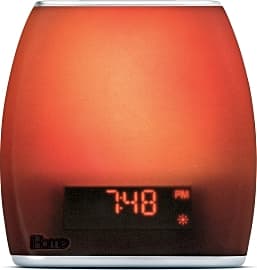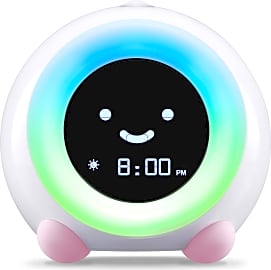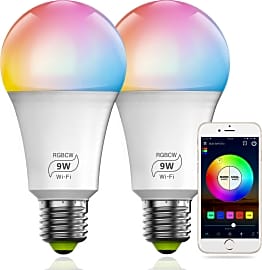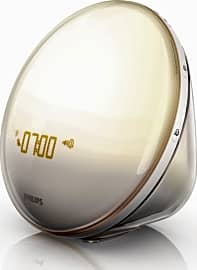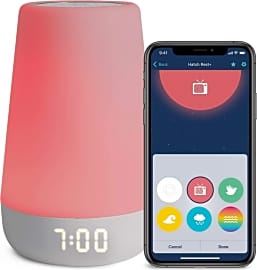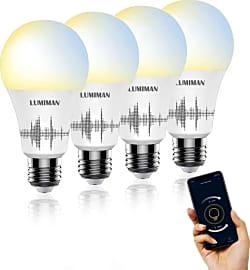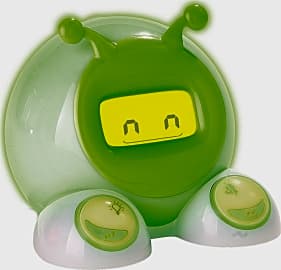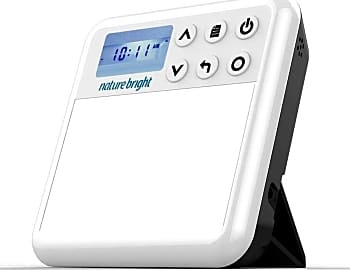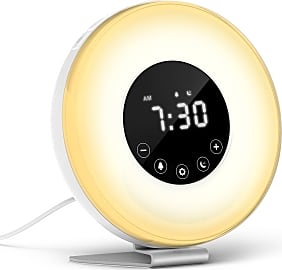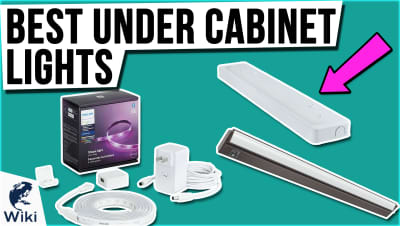The 10 Best Wake-Up Lights

This wiki has been updated 35 times since it was first published in September of 2016. If you have difficulty getting out of bed in the morning, you should consider trying one of these wake-up lights. Designed to mimic a sunrise, they can help you to open your eyes feeling alert and refreshed, and many also function as clocks, sound machines, and FM radios. Some models can even be paired with your smartphone for convenient control over the brightness, volume, and alarm settings. When users buy our independently chosen editorial picks, we may earn commissions to help fund the Wiki.
Editor's Notes
April 15, 2021:
In this update, we replaced the Flux Bluetooth with the Lumiman Tunable. Like the Flux, the Lumiman fits in a standard lightbulb socket and can either be controlled via a smartphone app or hooked up to a smart speaker like Google Home or Alexa. But the Flux had issues like an annoying high-pitched noise and a tendency to heat up quite a bit. While Lumiman also makes a bulb that can be set to a variety of colors, we chose the Tunable for its variety of shades of white. You can choose from a wide range of color temperatures, depending on whether you prefer warm or cool.
While we already had the Philips SmartSleep HF3670 on the list, we decided to add the Philips SmartSleep HF3520 as well in this update. While the HF3520 doesn't have as many features as the higher-end model (it can't connect to a smartphone app, has fewer brightness settings, and doesn't have built-in relaxation sounds) it is considerably more affordable and still offers plenty of useful functions, like automatic dimming, tap-to-snooze, and a selection of 5 different wake-up sounds.
Also new to the list is the Hatch Rest+. Unlike other models designed for kids (like the LittleHippo Mella and PlayMonster OK to Wake!) this one has a minimalist appearance with a clock on the base and a light on top, no cartoon face or pixelated animations. This makes it harder for your kids to outgrow it; you can simply utilize different functions depending on what they need as they grow up.
The Electrohome Retro was removed, as it has been discontinued by the manufacturer. We also removed the Mosche Sunrise as its controls weren't very user friendly and its shape made it easy to knock over, which can be especially frustrating with a device you deal with when you're tired in the morning.
March 26, 2020:
As our list reflects, wakeup lights come in an array of designs, including those that are quite simple, like the Electrohome Retro, which resembles an old-fashioned alarm clock, but which offers lights where there would otherwise be bells. On the other end of the spectrum are Bluetooth- and Wifi-enabled models, such as the Philips SmartSleep HF3670, our current number one pick. It emits a red-tinted glow that you can choose to combine with optional sounds of raindrops or ocean waves. It can be set and programmed via the intuitive smartphone companion app. It also offers some nice extras including a USB charging port and sensors that detect your room’s temperature, humidity, noise, and light levels.
Many people also choose to use these devices as light therapy lamps on gloomy days and during long winters. One that serves this purpose well is the Nature Bright Sun Bliss, which is equipped with a large LED panel that progressively gets brighter until it reaches its peak intensity. It incorporates a diffusion lens to protect your eyes.
Coming on board in this update is the iHome Zenergy Sleep Therapy, one of several models available from its manufacturer. It features an attractive design and can be set to glow in your choice of a wide variety of colors. This versatile choice also has a digital clock and an FM radio, and can be used as a speakerphone when you pair it with your smartphone. For the alarm, you can adjust the snooze duration to your liking, and a handy battery backup feature ensures you’ll still be woken up on time during a power outage.
Also joining the list is the LittleHippo Mella, which is great when you have an energetic little one who is eager to start the day at an hour that’s just too early. (As many a parent can attest to, this becomes particularly harrowing around the time the clocks move an hour backward each year.) This handy device is here to help, with a simple color-coded system that’s easy for little ones to understand. When it’s red (or any other color you choose to program), it’s time to be in bed. When it changes to yellow, your child will know that wake-up time is in 30 minutes, and when it finally changes to green, along with a smiley face, they'll know it’s officially time to get out of bed. The Mella joins a similar model on the list, the PlayMonster OK to Wake!, which is also good for sleep training a young child and comes with green and pink interchangeable faceplates and a screen with fun animations.
Leaving our selection today are the InLife E10 and the Glime LED, both of which are unavailable at this time.
Special Honors
Casper Glow Light This small, portable bedside light stands just five inches tall and is designed to wake you up gently, thanks to its warm, white glow that mimics that of a candle. It contains a gyroscope that enables you to turn it on simply by flipping it over, without the use of any buttons. To brighten or dim it, just rest it flat on a table and rotate it. It can be programmed to power on at a set time via the smartphone app, and once it’s on, it will gradually increase in intensity for 30 minutes until it hits its peak. You can also use the app to select which days of the week the light comes on, which proves useful if you like to sleep in on weekends. casper.com
Unexpected Consequences Of Not Getting Enough Sleep
The most important takeaway you can make, however, is that you need to get enough sleep every night if you want to be your best.
You already know that sleep is important, although it's a lot harder to remember that when it's midnight and you're binge-watching Netflix. But not catching enough Zs has a bigger impact on your body than you might think, with more dire consequences than simply feeling groggy at work.
One of the most unexpected effects of sleep deprivation involves weight gain. This seems counter-intuitive; how could spending less time in bed make you fatter? However, sleep helps regulate the hormones leptin and ghrelin, which affect your feelings of hunger and fullness. So, if you don't spend enough time hitting the hay, you're likely to spend more time hitting the buffet.
Conversely, one thing which probably won't surprise you about lack of sleep is that it can cause mood disorders. This much is obvious to anyone who talks to me before I've had my fourth cup of coffee in the morning. But beyond basic irritability, not getting enough shuteye affects your brain's ability to process information, which can lead to depression, impulsive behavior, paranoia, hallucinations, and more.
Your ability to fight off sickness is also affected by your rest habits. While you sleep, your body produces things like cytokines, which are basically the foot soldiers in the war against infection. If you don't get your forty winks in, your immune system won't be able to assemble much of a fighting force. Think about that the next time you wonder why you're always the one who catches the flu every year.
There are myriad more ways in which lack of sleep can sabotage your health, and researchers are learning more about slumber's effects on the body every day. The most important takeaway you can make, however, is that you need to get enough sleep every night if you want to be your best.
In fact, that's what you should tell your boss if he catches you napping on the job. Let me know if it works.
How Light Affects Your Sleep Cycle
Now that I've convinced you that you should make sleep a priority (I have convinced you, haven't I?), you should know that the best way to get the proper amount of rest is to establish a sleep schedule and stick to it. Yes, that means going to bed and getting up at roughly the same time every day, but trust me, it's worth it.
After all, our ancestors didn't have watches, so they used the sun to determine when to get up and when to go to bed.
Of course, if you've already tried and failed to stick to a sleep schedule, then you know it's not as easy as just setting an alarm or slipping between the sheets at a certain time. Your body is regulated by your circadian rhythm, which is basically your brain's best guess as to what time it is. One of the biggest factors in your mind's ability to determine time is how much light it's getting.
Makes sense, right? After all, our ancestors didn't have watches, so they used the sun to determine when to get up and when to go to bed. But you know what else our ancestors didn't have? Cell phones and TVs and tablets blasting light in their faces at all hours of the night, confusing their delicate internal clocks about what time it really was.
Of course, they also didn't have to wake up literally before the crack of dawn to beat traffic and get to work on time.
While human technology might have evolved by leaps and bounds over the centuries, our circadian rhythms haven't caught up, so you're going to have to trick yours. That means unplugging from all bright lights (especially blue ones) at least an hour before you go to sleep, and it means waking up to warm, refreshing light shining on your face.
That last part is where wake-up lights come in.
The Benefits Of Wake-Up Lights
As mentioned above, you can't always count on the sun to wake you up in the morning. You might need to get up before sunrise, or you may have a bedroom that doesn't face the dawn. In that case, you need to cheat, and a wake-up light is the best way to do it.
The clocks start by emitting a warm glow a little while before your alarm is set to go off.
The clocks start by emitting a warm glow a little while before your alarm is set to go off. This allows your body to process the fact that dawn is breaking, and you'll begin to transition into lighter, non-REM sleep. This is important, because if you wake up immediately out of deeper sleep, you'll feel extremely groggy, and it will take you longer to get ready to confront the day.
The light gets gradually brighter the closer it gets to your designated wake-up time, and then, when it's time to wake up, your buzzer will go off. At this point, it's as bright as a summer morn in your bedroom, so it's hard for even the most dedicated snoozers to sleep through their alarm. Fair warning, though: if you sleep with your eyes covered, the brightness may not affect you at all.
Wake-up lights are great for non-morning people who nevertheless have to wake up early for work, or for city-dwellers who can't leave their drapes open all night because the city lights affect their ability to rest. People who are naturally early risers may not see as much benefit, unless they just want to add a little brightness to their mornings.
Regardless, waking up to a room bathed in a warm, refreshing glow is significantly more satisfying than being jarred awake by an obnoxious beeping. After all, if I wanted to wake up to blaring noises, I wouldn't have taken the batteries out of my smoke detectors (note: please don't do this).


